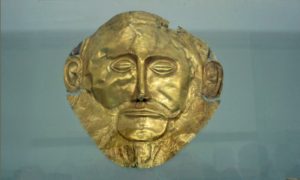
“Mask of Agamemnon” in Athens’ National Archaeological Museum (Photo by Don Knebel)
Schliemann was the most famous archaeologist of the nineteenth century, known as much for his self-promotion, sometime based on outright falsehoods, as for his archaeological discoveries. He is best known for having uncovered what he claimed was the legendary City of Troy, the site of the Trojan War made famous by the Iliad. Convinced that Homer’s epic poem was based on actual events, Schliemann set out to find the tomb of Agamemnon, the mythical King of Mycenae who commanded the victorious Greek forces against the Trojans and was murdered upon his return by his wife’s lover. In 1876, while digging at Mycenae, Schliemann found five well-preserved male bodies, the face of each covered by a mask. The most elaborate of the masks, made from a sheet of gold hammered over a wooden mold, showed a bearded man with his eyes appearing both open and closed. The ears were cut out to allow the mask to be fastened to the head with string. Claiming the mask resembled an illustration of Agamemnon, Schliemann told the King of Greece he had gazed into the face of the legendary king.
Some skeptics, influenced by Schliemann’s truth problems, claimed he forged the mask from the illustration and planted it at the excavation site. However, most scholars believe the so-called “Mask of Agamemnon” is authentic, but fashioned in about 1500 B.C., 300 years before the reckoned date of the Trojan War and 200 years before the famous gold of Tutankhamen. Whether Agamemnon existed remains a mystery.